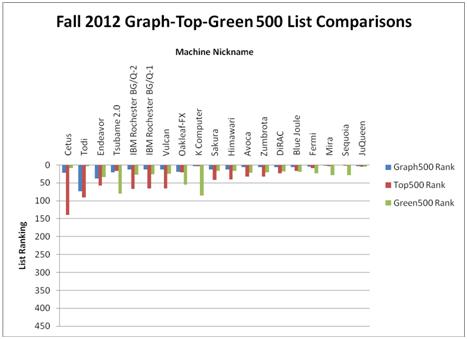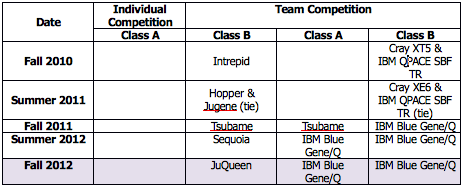The semi-annual HPC “500 list” time and its attendant fall iron horse racing season are upon us. Thanks to the hard work of the list keepers, we currently enjoy three major ones to review, compare and contrast: TOP500, Green500 and Graph 500. Each focuses on a distinct aspect of HPC – number crunching, energy efficiency, and data crunching, respectively – and together they allow us to construct our own type of Triple Crown. Since new race results were recently announced, let’s take a look at the current standings.
In racing with real horses, a Triple Crown consists of a series of three races for three-year-old thoroughbred horses. Winning all three of these races is considered to be the greatest accomplishment of a horse’s career. Various nations, where thoroughbred racing is popular, each have their own Triple Crown series. Since HPC is a global sport, we enjoy the simplicity of only having one Triple Crown: our three 500 lists – the TOP, Green and Graph 500s. How do our HPC iron horses do in competing to win this Triple Crown? Let’s review the past year’s races and then look at the Fall 2012 competition.
Last fall, strictly speaking, there was no Triple Crown winner. No single machine occupied the top spot on all three rankings, but Tsubame clearly was the best all-around performer. Of those machines competing in all three races, Tsubame ranked closest to the top overall (see Number Crunching, Data Crunching and Energy Efficiency: the HPC Hat Trick). To refresh your memories, there’s a graphic below depicting the outcome. Also, you may wish to consult the three lists – TOP500, Green500, and Graph 500 – to learn more about the machines behind the nicknames used here.
Note that three of the fall 2011 top five TOP500 computers were missing from the comparison: K Computer (#1), Tianhe-1A (#2), and Nebulae (#4). This was because they were not included in the Graph 500. However, because of the relatively low ranking of those three machines on the Green500, the outcome of the comparison was not affected.

As discussed in the previously cited article, the constraint on this three-way comparison was the population of the Graph 500 list. While there is essentially complete overlap and obvious mapping between TOP500 and Green500 machine entries, for the Graph 500 this is not the case. The Graph 500 list was and is a work in progress. The fall 2011 version contained only 49 distinct computers and did not provide any mapping of these to either the TOP500 or the Green500 list. Nonetheless, it was possible to locate at least 19 Graph 500 computers on the other two lists – the ones named in the graphic above.
It would be nice to have not only a winner of our semi-annual iron horse races, but also a Triple Crown winner as well. Perhaps there are alternative definitions of the competition that would improve the odds of this happening.
Suppose we considered both “individual” and “team” competitions and a couple of “winning” categories within each competition. For example:
Individual Triple Crown
Class A Winner: Specific machine in first place on all three lists
Class B Winner: Specific machine present on all three lists & highest average rank
So, the individual competition looks as one might expect, except we admit the possibility of a Class B winner, based on highest average rank across all three lists. This pretty much ensures an individual winner even if one machine doesn’t glean the top spot on every list. In the fall of 2011, Tsubame would have been the Class B winner.
For the team competition, suppose we looked not for a specific machine (for example, Hopper) to win but instead for a type of machine (such as the Cray XE6)? Then, since the most attention is paid to the top of the lists, we might define “winning” a particular race to be having the greatest number of that machine type in the top 10 on that list. We could also then form aggregate scores for the winners in each list race by summing across all three lists.
Team Triple Crown
Class A Winner: Machine type present in the top 10 on each list & highest aggregate score
Class B Winner: Machine type present in the top 10 on at least one list & highest aggregate score
If we review the fall 2011 500 lists using our new definitions, we find:
Individual Competition
Class A Winner: None
Class B Winner: Tsubame
The input data for the team competition are summarized in the table below. The maximum number of occurrences of a particular machine type in the top 10 for each 500 list is shown in red.

These data yield:
Team Competition
Class A Winner: Tsubame (a team with one member)
Class B Winner: IBM Blue Gene/Q
If you think that just looking at the top 10 spots on the 500 lists is too restrictive, then use your own cutoff or include the whole of each list. Designing the competition is a game anyone can play. We’ve chosen the top 10 because that part of the 500 lists seems to draw the most attention from the HPC community.
Let’s see how events played out in the summer 2012 races.
Here once again we see that the small population of the Graph 500 constrains the comparisons. To be sure, the list is expanding. The summer 2012 version contained 89 entries, which was almost twice as many as the previous list, but we were still only able to clearly identify 19 of them as being included in the other two lists. Using those 19, the comparisons are shown in the graphic below.

Individual Competition
Class A Winner: None
Class B Winner: Sequoia (by a nose over Mira)
Once again, the input data for the team competition are summarized in the yable below.

This data yields:
Team Competition
Class A Winner: IBM Blue Gene/Q
Class B Winner: IBM Blue Gene/Q
The IBM Blue Gene/Q is the summer 2012 Class A and Class B Triple Crown team competition winner. Sequoia – an IBM Blue Gene/Q system at Lawrence Livermore National Laboratory – is the Class B Triple Crown individual competition winner and also finished first on both the TOP500 and the Graph 500. Another Blue Gene/Q system beat Sequoia out for the top spot on the Green500. Sequoia finished in 20th place on the Green500, having been beaten by 19 other Blue Gene/Q systems.
Another Blue Gene/Q system – Mira, located at the Argonne National Laboratory – was nosed out by Sequoia, in a photo finish, in the individual competition. So, machines from the IBM Stables dominated the Summer 2012 competitions.
Now, on to the current race results.
In November 2012, the population of the Graph 500 list expanded fairly substantially. This version contains 124 entries, almost 40 percent more than the previous one. While we were only able to clearly identify 41 of them as being included in the other two 500 lists, this is more than twice as many as our previous comparisons contained. For consistency with those previous comparisons, we’ve taken the top 19 of those 41 and compared their rankings on all three lists in the graphic below. We’ve also maintained the same vertical axis scale used previously, for ease in viewing across all three graphics.

Individual Competition
Class A Winner: None
Class B Winner: JuQueen
The input data for the team competition are summarized in the table below.

These data yield:
Team Competition
Class A Winner: IBM Blue Gene/Q
Class B Winner: IBM Blue Gene/Q
The IBM Blue Gene/Q is the fall 2012 Class A and Class B Triple Crown team competition winner. JuQueen – an IBM Blue Gene/Q system at Forschungszentrum Jülich (FZJ) in Germany – is the Class B Triple Crown individual competition winner and thus becomes the first European winner of the Class B individual competition. Also notable is that every system in the Top 10 for this Triple Crown competition is an IBM Blue Gene/Q (JuQueen through Sakura). So, once again, machines from the IBM stables dominated the fall 2012 races.
Where, in all of this, is Titan, you might ask. Well, unfortunately, Titan, a Cray XK7 and the TOP500 race winner, did not compete in the Graph 500.
We’ve summarized the results of all HPC Triple Crown competitions in the table below and highlighted the row containing the new results.

So far, no machine has won the Class A individual competition and only two machine types have won the Class A team competition – Tsubame and Blue Gene/Q. Here’s a table of those machines which have come closest to winning the Class A individual competition.
|
Date |
Machine |
Ranking on “500 List” |
Average Ranking |
||
|
Top500 |
Green500 |
Graph500 |
|||
|
Fall 2010 |
13 |
29 |
1 |
14.3 |
|
|
Summer 2011 |
8 |
42 |
4 |
18 |
|
|
12 |
40 |
2 |
18 |
||
|
Fall 2011 |
5 |
10 |
3 |
6 |
|
|
Summer 2012 |
1 |
20 |
1 |
7.3 |
|
|
Fall 2012 |
5 |
5 |
3 |
4.3 |
|
Will some iron horse win the Class A individual Triple Crown next time, or is placing first on all three 500 lists just too hard? Will the IBM stables continue to dominate or will Titan or some other machine steal some of the glory? Will the Graph 500 continue to grow and include more of the machines on the other two 500 lists? We’ll see what happens next summer.
In real horse racing, winning the Triple Crown accords prestige to horses, their humans and stables; adds economic value to the winners and their offspring; and provides entertainment for racing fans. Our iron horse races serve just about the same purposes. So, HPC racing fans, do your own analysis of the race results, take a look at the iron horses likely to race well next time, get ready to place your bets, and enjoy the upcoming summer 2013 races!
About the Author
 Gary M. Johnson is the founder of Computational Science Solutions, LLC, whose mission is to develop, advocate, and implement solutions for the global computational science and engineering community.
Gary M. Johnson is the founder of Computational Science Solutions, LLC, whose mission is to develop, advocate, and implement solutions for the global computational science and engineering community.
Dr. Johnson specializes in management of high performance computing, applied mathematics, and computational science research activities; advocacy, development, and management of high performance computing centers; development of national science and technology policy; and creation of education and research programs in computational engineering and science.
He has worked in academia, industry and government. He has held full professorships at Colorado State University and George Mason University, been a researcher at United Technologies Research Center, and worked for the Department of Defense, NASA, and the Department of Energy.
He is a graduate of the U.S. Air Force Academy; holds advanced degrees from Caltech and the von Karman Institute; and has a Ph.D. in applied sciences from the University of Brussels.




























































